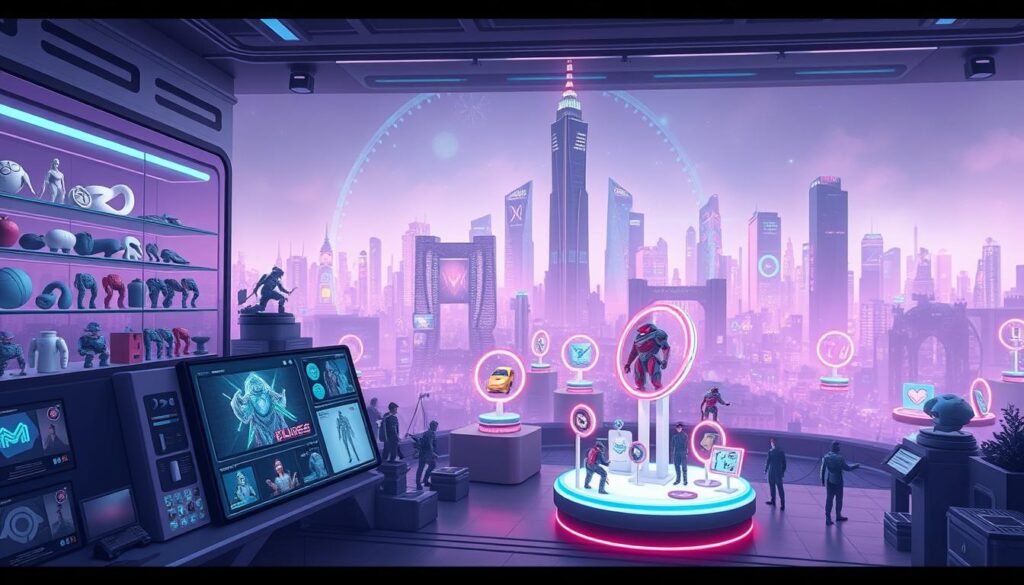The digital world is evolving rapidly, and a new wave of influencers is taking center stage. These aren’t your typical human personalities but computer-generated personas powered by artificial intelligence. Names like Lil Miquela and Noonoouri have become household names, partnering with iconic brands such as Ugg and Dior.
What sets these influencers apart is their ability to generate content consistently, thanks to cutting-edge technology. Unlike human influencers, they don’t need breaks or downtime. This makes them a powerful tool for brands looking to maintain a strong presence on any platform.
This shift isn’t just a trend; it’s a game-changer. By leveraging artificial intelligence, businesses can create tailored content that resonates with their audience. Whether it’s high-fashion campaigns or everyday promotions, these virtual personas are redefining the way we think about influence.
Introduction: The Rise of AI-Powered Virtual Influencers
The rise of digital personas is reshaping the influencer landscape. These computer-generated figures are not just a novelty; they’re a multi-million dollar opportunity. Powered by artificial intelligence, they’re transforming how brands connect with audiences in today’s fast-paced digital world.
What Are AI-Powered Virtual Influencers?
AI-powered virtual influencers are digital characters created using advanced technology. Unlike traditional influencers, they don’t rely on human input for every post or campaign. Instead, they use artificial intelligence to generate content, engage with followers, and maintain a consistent presence. For example, Lil Miquela, with over 2.5 million Instagram followers, has become a global sensation.
These influencers are available 24/7, ensuring constant engagement with their audience. They can analyze data to determine what content resonates most, whether it’s fashion, travel, or lifestyle posts. This makes them a powerful tool for brands looking to stay relevant in today’s ever-changing social media world.
Why They Matter Today
In today’s digital age, AI-powered influencers are more than just a trend. They represent a shift in how brands approach marketing. With their ability to work around the clock and adapt to audience preferences, they offer a level of consistency and creativity that human influencers can’t match.
Brands like Prada and Calvin Klein have already embraced this technology, collaborating with virtual influencers to reach younger, tech-savvy audiences. These partnerships highlight the growing importance of artificial intelligence in the influencer marketing space. As the digital world continues to evolve, these virtual personas are set to play an even bigger role in shaping the future of social media.
Understanding AI Influencer Technology
Artificial intelligence is revolutionizing how content is created and shared on social media. With advanced tools, brands can now craft engaging posts, analyze audience behavior, and maintain a consistent presence. This technology is not just a trend; it’s a game-changer for the influencer marketing industry.
The Role of Artificial Intelligence in Social Media
AI plays a crucial role in automating content creation and enhancing engagement. Tools like image generators and voice synthesizers allow influencers to produce high-quality posts quickly. For example, Lil Miquela uses AI to craft her Instagram content, ensuring her feed remains fresh and relevant.
These tools also analyze data to determine what resonates with audiences. Whether it’s fashion, travel, or lifestyle, AI helps influencers tailor their content to meet specific preferences. This level of personalization is what makes AI-driven influencers so effective on social media platforms.
Differences Between Virtual and Human Influencers
Virtual influencers offer unique advantages over their human counterparts. They are available 24/7, ensuring constant engagement with their audience. Unlike human influencers, they don’t require breaks or downtime, making them a reliable choice for brands.
Another key difference is scalability. AI influencers can change their appearance instantly and adapt to new trends faster. For instance, Shudu, a virtual influencer, has worked with luxury brands like Louis Vuitton, showcasing her versatility and appeal.
Consistency is another benefit. AI influencers maintain a steady presence, which is crucial for brands looking to build long-term relationships with their audience. This consistency, combined with lower costs, makes them a valuable asset in the influencer marketing space.
Paid Brand Collaborations and Sponsorships
Brands are increasingly turning to digital personalities for innovative marketing strategies. These collaborations offer a unique way to connect with your audience while maintaining a consistent brand image. From fashion to tech, AI-driven influencers are proving their value in the marketing world.
Case Studies: Ugg, Noonoouri, and More
Take Ugg’s anniversary campaign, for example. They partnered with Lil Miquela to create a series of posts that resonated with their audience. The campaign highlighted their product in a way that felt authentic and engaging. Similarly, Noonoouri’s collaborations with Dior and Thierry Mugler showcased her versatility in high-fashion settings.
These partnerships demonstrate how digital influencers can elevate a brand’s image. By aligning with the right influencer, you can create campaigns that feel fresh and relevant to your audience.
Maximizing Campaign Value
To get the most out of your collaborations, focus on consistency. Use high-quality images and ensure your product service aligns with the influencer’s persona. This step helps build trust with your audience.
Another key step is to analyze campaign performance. Use data to understand what works and refine your strategy. This approach ensures your campaigns remain effective and relevant.
Finally, keep your audience in mind. Tailor your content to their preferences and interests. This alignment helps create campaigns that truly resonate and drive results.
Selling Digital Assets and Virtual Merchandise
The digital marketplace is expanding, offering new ways to monetize creativity. From exclusive virtual goods to unique digital content, there are endless opportunities to generate revenue. Whether you’re a creator or a brand, leveraging these strategies can open doors to innovative income streams.

Ecommerce Channels for Digital Goods
Platforms like Gumroad have made it easier than ever to sell digital products directly to your audience. These channels allow you to offer exclusive content, such as templates, art, or even virtual merchandise. By creating a seamless shopping experience, you can build a loyal customer base.
For example, many creators use these platforms to sell printable designs or digital guides. This approach not only generates income but also strengthens your brand’s presence in the digital space. With the right strategy, you can turn your creativity into a sustainable business.
NFTs and Digital Licensing Opportunities
NFTs have revolutionized the way we think about ownership and creativity. By tokenizing your work, you can sell unique digital assets that hold value in the blockchain. This method has been successfully used by virtual influencers like Lil Miquela, whose NFT “Rebirth of Venus” sold for over $82,000.
Digital licensing is another avenue to explore. By licensing your persona or designs, you can earn royalties each time your work is used. This creates a passive income stream that complements your active sales efforts.
To succeed in this space, focus on creating high-quality, unique content. Use video and other engaging formats to showcase your work and attract buyers. Pairing these strategies with affiliate marketing can further amplify your reach and revenue.
Leveraging Social Media Platforms & Content Creation
Social media platforms have become a goldmine for content creators looking to grow their influence. With the right strategies, you can turn your posts into a steady income stream. Whether you’re a brand or an individual, understanding how to maximize these platforms is essential.
Sponsored Content and Ad Revenue Sharing
Sponsored posts are one of the most effective ways to earn on social media. Brands pay you to feature their products or services in your content. To succeed, align your endorsements with your character’s voice. This ensures authenticity and resonates with your audience.
Ad revenue sharing is another lucrative option. Platforms like YouTube allow you to earn a share of the ad revenue generated from your videos. Focus on creating engaging content that keeps viewers hooked. The longer they stay, the more you earn.
Affiliate Marketing Strategies
Affiliate marketing is a powerful way to boost your income. By promoting products through unique links, you earn a commission for every sale. Choose products that align with your niche and audience preferences. This increases the likelihood of conversions.
To maximize results, track your performance. Use analytics to identify which posts drive the most clicks and sales. This data helps you refine your strategy and focus on what works best.
Remember, consistency is key. Regularly share valuable content that builds trust with your audience. Over time, this approach can turn your social media presence into a sustainable income source.
Entertainment and Event Collaborations
The entertainment industry is embracing a new era of digital creativity. AI-driven personas are stepping into the spotlight, offering unique ways to engage audiences. From virtual concerts to mainstream media campaigns, these collaborations are reshaping how we experience entertainment.
Digital Concerts and Virtual Tours
Virtual events are becoming a cornerstone of modern engagement. Platforms like Fortnite have hosted digital concerts featuring artists like Travis Scott, attracting millions of viewers. These events offer an immersive experience that traditional concerts can’t match.
AI-driven influencers are also leading virtual tours, allowing fans to explore digital worlds. These tours provide a unique opportunity for brands to connect with audiences in innovative ways. By leveraging social media platforms, you can create interactive experiences that keep viewers coming back for more.
Mainstream Media Integrations
Mainstream media is integrating digital personas into its storytelling. Calvin Klein’s ad campaigns featuring Lil Miquela are a prime example. These collaborations blend creativity with technology, reaching younger, tech-savvy audiences.
These integrations offer a consistent service that keeps audiences engaged. By partnering with digital influencers, brands can create campaigns that feel fresh and relevant. This approach not only boosts engagement but also opens new revenue streams.
Whether it’s a virtual concert or a media campaign, these collaborations are transforming the entertainment landscape. They provide a unique opportunity to connect with audiences in ways that were once unimaginable.
Innovative Applications Beyond Marketing
AI-driven characters are breaking barriers beyond traditional marketing roles. These digital personas are now stepping into sectors like education and corporate training, offering unique solutions for modern challenges. Their adaptability makes them a valuable asset for any business looking to innovate.
Virtual Education and Corporate Training
One of the most exciting applications is in virtual education. AI influencers are being used as tutors, providing personalized learning experiences for users. For example, digital characters can teach languages, math, or even coding, adapting their methods based on the learner’s progress.
In corporate training, these personas are revolutionizing how companies onboard and upskill employees. AI-driven trainers can conduct sessions on leadership, compliance, or technical skills. Studies show that such tools can reduce training costs by 40% while improving learning retention by 60%.
Trust is key in these roles. By delivering consistent and reliable service, AI influencers build credibility with their audience. This makes them a dependable tool for businesses aiming to enhance their training programs.
The potential of influencer making in these sectors is immense. As technology evolves, we can expect even more innovative uses for digital personas. Whether it’s education or corporate training, AI-driven characters are proving their worth in ways that go far beyond traditional marketing.
Building & Managing Your AI Influencer Brand
Creating a standout AI influencer brand requires a blend of creativity and strategy. Your digital persona must resonate with your audience while staying true to your brand’s identity. This section will guide you through the essential steps to design, launch, and maintain a successful AI influencer.

Character Design and Platform Selection
Start by designing a model that aligns with your brand’s vision. Consider factors like appearance, personality, and tone. For example, a fashion-focused influencer might have a sleek, modern look, while a lifestyle influencer could feel more approachable and relatable.
Next, choose the right platform. Instagram and TikTok are popular for visual content, while platforms like OnlyFans offer niche opportunities. Linking your influencer to the right platform ensures maximum engagement and reach.
Stay ahead of the trend by analyzing what works in your industry. Use tools like Virbo for video production to create cohesive imagery that stands out. Consistency in design and content is key to building trust with your audience.
Maintaining Authentic Digital Personas
Authenticity is crucial in digital marketing. Your audience should feel a genuine connection to your influencer. Schedule posts regularly to maintain a consistent presence, and ensure your content reflects your brand’s values.
Adapt to emerging trends to keep your influencer relevant. For instance, if short-form videos are trending, incorporate them into your strategy. This approach keeps your content fresh and engaging.
Prepare for the future by staying updated on technological advancements. As audience behavior evolves, your influencer should adapt to meet their expectations. This forward-thinking mindset ensures long-term success in the competitive digital space.
Conclusion
The future of digital engagement is here, and it’s powered by cutting-edge technology. Throughout this article, we’ve explored how innovative media platforms and strategies can help you build a loyal fan base while effectively engaging your audience.
By adopting proven techniques, you can create a consistent presence that resonates with your followers. The ability to adapt to emerging trends ensures your brand remains relevant in the ever-evolving digital landscape.
Take proactive steps to establish and grow your own digital persona. Leverage the scalability and cost-effectiveness of AI-driven tools to maximize your impact. The opportunities are vast, and the time to act is now.
